Furry moths may baffle by their appearance. A hairy body and hairy wings are seen on numerous types of moths in North America.
This fluffy appearance can help distinguish moths between them as well as from butterflies.
Table of Contents
Why Are Moths Furry?
It may appear moths are furry without a reason. But the fuzzy cover of their bodies has a few functions as follows.
Heat regulation
Vital body functions are protected by the fluff seen on moths. These hairs help moths with heat regulation and increase survival chances with temperature changes.
Protection against bat sonars
Moth predators such as bats use echolocation to find prey such as moths. A fuzzy body blocks these types of sound waves.
Protection from bumps
A furry body acts as a safety barrier for moths bumping into various objects. This might be one of the reasons the body of moths has more fuzz.
Common Furry, Fluffy, Hairy Moths
Some of the most common furry moths in North America include the following species.
1. Isabella Tiger Moth

These types of moths (Pyrrharctia isabella) are known for their long hairs across their life stages. Both adults emerged moths and the larvae of the Isabella Tiger Moth have long hairs.
Various shades of brown and black are the color combinations of the adult moth and the caterpillar.
These moths have light brown short hairs across their wings and on their body.
Darjer brown coloring is specific to the body while its wings have lighter brown hairs.
The black spots along its body are also formed with short black hairs.
Some Isabella Tiger Moths have a yellow color with short hairs along their wings and a long brown head on the back of its head.
2. Polyphemus Moth

The fluffy Polyphemus Moth (Antheraea polyphemus) is one of the species with a combination of short and long hairs.
Both its dorsal and its ventral sides are covered in hairs.
Moths of the species have brown hairs across the dorsal wings with large yellow and blue eyespots. Long furry hairs are seen on its body as well.
Grey is the main ventral coloring of the species with similar shorter hairs on the wings and longer hairs on the body.
Its antennae are also fuzzy, with a feather-like appearance.
This is a large moth species reaching a wingspan of 5-6 inches.
It can be seen in the spring in an early brood and later in the summer in a second brood.
3. Fall Webworm Moth
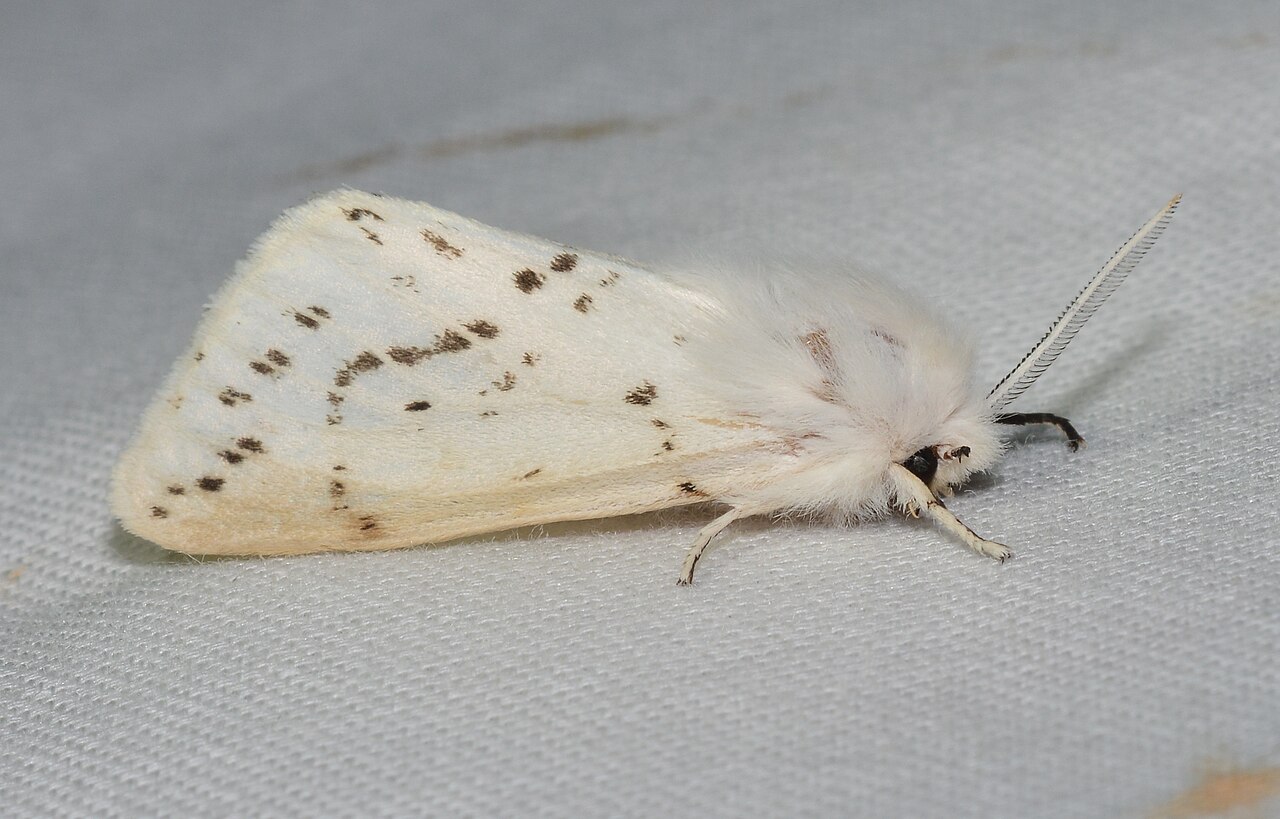
This large type of moth (Hyphantria cunea) is a North American native.
It can be found feeding on the leaves of various trees across woodlands. This species eats the leaves of trees and it carries a risk of defoliation.
A fuzzy body is specific to this month.
Its upper body has fine hairs that resemble fluff. Its lower body is covered in shorter hairs. Short hairs are specific to its wings.
Both its wings and its body are almost pure white.
Most types of hairy Fall Webworm Moths have a white color but some moths also show additional black spots along the wings.
4. Eastern Tent Caterpillar Moth

A fuzzy appearance is also specific to The Eastern Tent Caterpillar (Malacosoma americana).
This species has dark brown hairs along its wings and its body. Like most fluffy moths, the longest hairs are concentrated on the upper side of its body.
Faint white lines are seen across its wings.
The underside of the species is characterized by longer hairs of various brown nuances.
A hairy body is also specific to its caterpillar. Scarce and long brown hairs are seen along its body while short hairs cover the entire body with brown, black, and blue coloring.
Complete tree defoliation is specific to this species as a major pest.
5. Virginian Tiger Moth

A white fluffy upper body is specific to The Virginian Tiger Moth (Spilosoma virginica).
Pure white or pearl white coloring is specific to the species. Its wings have very short hairs while its upper body has long fuzzy white hairs.
Its lower body is white and black. There are 6 black spots along its body.
Tiger moths, in general, may have long hairs as caterpillars. This is also the case with the Virginian Tiger Moth Caterpillar.
The caterpillars of the species have long yellow to brown hairs.
Each growth stage comes with additional hair growth so many species perceived it as an irritating caterpillar.
6. Forest Tent Caterpillar Moth

Some of the common trees in North America are the hosts for this furry moth (Malacosoma disstria).
Brown colors are specific to the species, together with grey nuances. A light brown base color is contrasted by a wide dark brown stripe along its wings.
The Forest Tent Caterpillar Moth is a species with short and long hairs along its wings and body.
Even its caterpillar is known for growing long hairs.
Light brown to tan hairs only grow along the sides of the Forest Tent Caterpillar. The rest of its body is black, blue, and white.
This caterpillar has a damaging role by feeding on the leaves of tupelo, oak, or maple.
7. Spongy Moth

Spongy Moths (Lymantria dispar) are among the fluffy moths that have long hairs both on the body and across the wings.
The central areas of the wings closest to the body have the longest hairs while shorter hairs are seen on the edges of the wings.
Yellow or yellow-brown and black color is seen on this species.
Unlike other moths, it also shows longer hairs both on its upper body and on its lower body.
Its caterpillars are also marked by multiple scarce hairs as well as by tufts of hairs or multiple grouped hairs that make predators look away.
8. Rosy Maple Moth
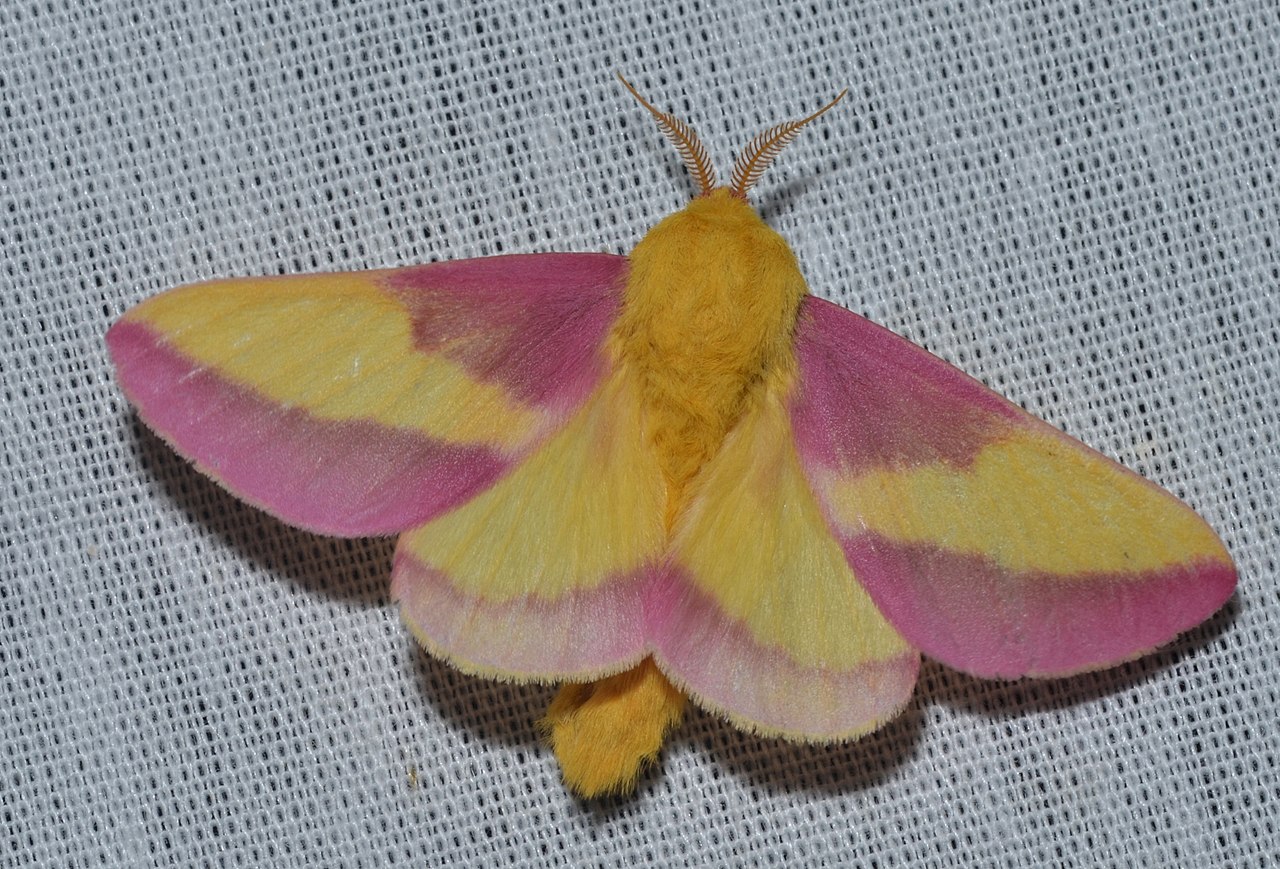
One of the most common types of colorful fuzzy moths is the Rosy Maple Moth (Dryocampa rubicunda).
This is a type of hairy moth with short yellow hair and a yellow body. Its wings don’t have hairs but are also yellow and pink.
Its legs are pink as well and scarcely covered in hair.
The appearance of this colorful rose and yellow moth is not similar to the appearance of its green caterpillar.
The Rosy Maple Moth Caterpillar has a hairless body.
Caterpillars of this species can be spotted on various types of maple.
9. White-speck Moth

One of the hairy species of North America with different ventral and dorsal colors is the White-speck Moth (Mythimna unipuncta).
Dark brown and cream colors are seen on its dorsal side while its ventral side is mostly gray and white.
A hairy body is specific to this species. The upper body and the forewings have a brown color while the lower body and the hindwings are mostly white.
The caterpillar of the species is also brown, with scarce short light brown hairs.
Pest status is attributed to the species. These are a type of caterpillars that need to be managed with insecticides are they carry defoliation and stunted plant growth risks.
The beginning of the summer marks the period this species is most active.
10. Io Moth

Male and female Io Moths (Automeris io) have short colored hairs covering their bodies.
The male Io Moth has dark hairs across its body and dark forewings. Large eyespots are seen on its hindwings.
Females are dominated by yellow coloring and short hair. The hindwings of the females are also dominated by large black eyespots.
These eyespots are only visible when males and females fly.
Io Moth Caterpillars have long spikes that may look like hairs. These spikes are urticating and highly irritating on the skin.
Maple and boxelder are some of the specific hosts of the Io Moth.
11. Corn Earworm Moth

Many see the furry Corn Earworm Moth (Helicoverpa zea) as the most damaging type of pest moth in North America.
It invades crops where it eats various hosts leading to considerable economic losses.
This is a species that feeds on corn, cotton, tomato, asparagus, cantaloupe, and other fruits or legumes.
Most of its large-scale damages are specific to areas where the species manage to overwinter, but not in some of the Northernmost habits of the US.
A hairy brown body
and hairy light brown and dark brown wings are specific to the species. Its hindwings are marked by darker edges and white inner sections.
12. Southern Flannel Moth
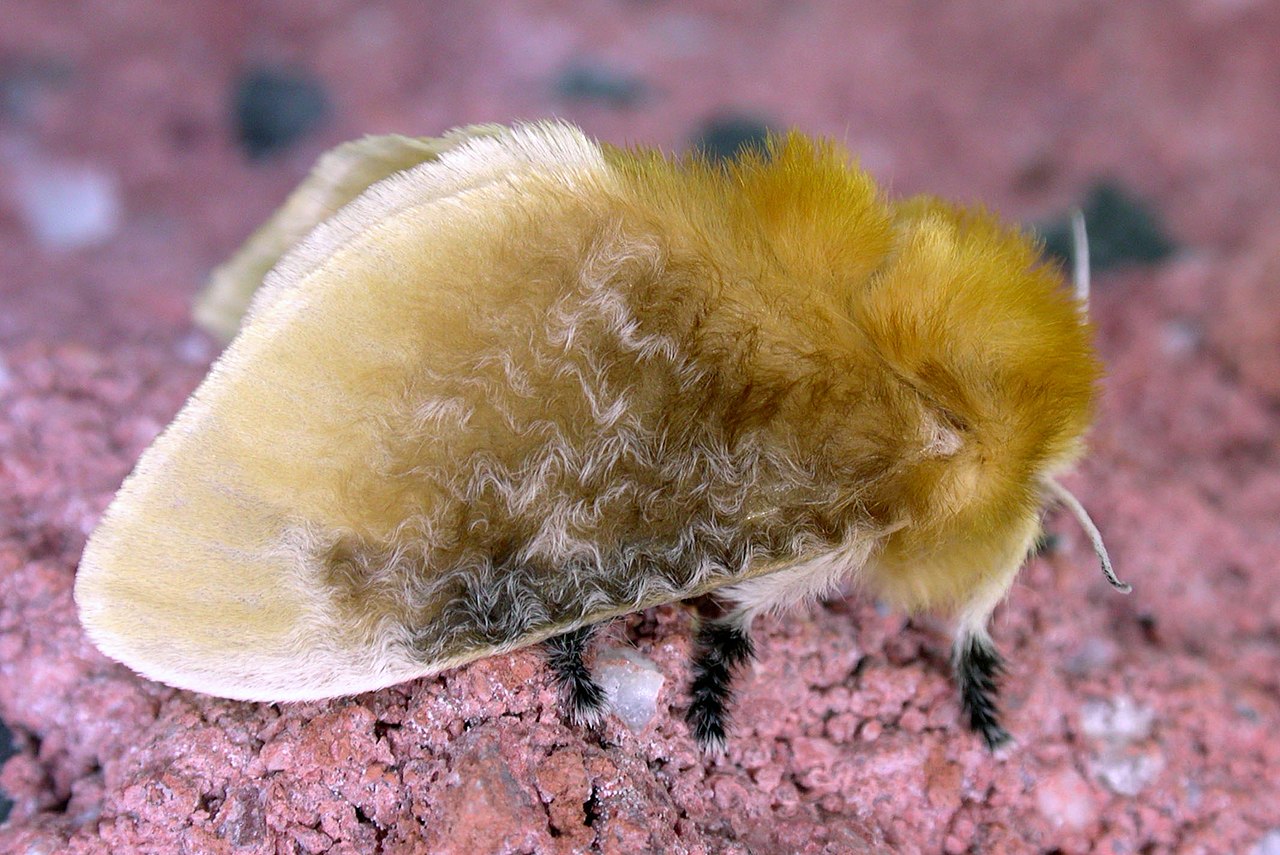
One of the most dangerous types of fluffy moths and caterpillars are those of the Southern Flannel Moth species (Megalopyge opercularis).
A hairy yellow and brown body is specific to adults which also have hairy brown and white wings.
Its caterpillar is one of the hairiest in the moth world, being compared to a furry animal at times.
The hairy body of the Southern Flannel Moth Caterpillar is dangerous as direct skin contact is painful.
Its hairs are stiff and may attach to the skin which means they need to be manually removed.
The species is a common sight on oak and elm trees.
Most of its habitats include an area between the Southeastern states and Mexico.
13. Dot-lined White

Much of the same host trees of the Southern Flannel Moth are also specific to the hairy Dot-lined White (Artace cribrarius).
Oak and wild plum species of the Eastern United States are among the typical hosts of this species.
The moth is identified by its almost uniform white wings and body.
Short black stripes are seen along its wings.
A fluffy upper body and lower body are specific to this species. Its body is white, as are its wings.
Most tree damages associated with the Dot-lined White caterpillar are specific to the summer period, up to October.
14. Large Tolype Moth

Poplar, aspen, and linden are just some of the common hosts of the Large Tolype Moth (Tolype velleda).
This species has a fuzzy appearance dominated by gray and white colors.
Long white and gray hairs are seen on its dorsal upper body in high density. Long but scarce hairs are also seen on its lower body.
The wings of the species have shorter gray and white hairs while its antennae have a fuzzy feather-like appearance.
Only one Large Tolype Moth brood emerged per year.
A wide territory in the Eastern parts of North America where trees such as orchard apples and linden grow is its main habitat.
15. Black-waved Flannel Moth

Alder, blackberry, and apple are some of the typical Eastern US hosts of the Black-waved Flannel Moth (Megalopyge crispata).
A hairy adult moth’s body and fluffy caterpillar appearance make this species stand out.
The adult is dominated by white colors, combined with yellow, light brown, and black colors.
A high number of hairs covers its body, wings, legs, and antennae.
Caterpillars of the species are covered in pure white hairs and they have an urticating effect.
These types of caterpillars might lead to skin conditions such as dermatitis that last up to a few days.
Some of the first signs of the impact this species has on its host plants include brown spots on leaves, followed by dead leaves and branches.
16. Pink-Striped Oakworm Moth

The Pink-striped Oakworm Moth (Anisota virginiensis) is one of the moths with a very hairy body and barely any hairs on its wings.
The orange coloring is specific to this species. Males tend to have red undertones to their base color and red to brown wings.
This is a species further known for its implication in eating all types of leaves in deciduous woodlands.
Furthermore, these moths are true pests as they may lead to complete tree and woodland defoliations in the case of outbreaks.
The Pinks-striped Oakworm Moth may be seen in a tandem flight as males and females are among the few months that remain together after mating, at least for a few hours.
17. White-dotted Prominent

White-dotted Prominent Moths (Nadata gibbosa) are natives of North America. They live in a wide habitat from the snowy woodlands in the Northern parts of the continent to Southern Florida.
This is also a species that is rarely seen as it always comes out after nightfall.
A final flight is made before sunrise as the moth prepares to rest.
Tan and orange nuances are the most specific to this species.
A hairy tan body and brighter wings are seen in this species.
There are no hairs on the White-dotted Prominent caterpillar which is mostly green.
18. Agreeable Tiger Moth

A furry appearance is also specific to the Agreeable Tiger Moth (Spilosoma congrua) which has an orange section on its upper body, unlike other white moths.
Its body is hairy. Most of its hairs are seen on the upper body.
Small dark gray to black spots is further distinguishable on its body.
Similar to The Virginia Tiger Moth, this white furry moth also has hairy caterpillars.
Black and orange bands across the body are specific to this caterpillar. Long black hairs cover the black sections of the caterpillar.
19. Buck Moth

Scrub oak and other types of oak are the hosts of Buck Moths (Hemileuca maia).
The body of Buck Moth caterpillars is furry. Long hairs of various colors are seen along its body.
Its upper body is dark grey. The mid-section has white and black hair. The lower body of the species has short orange or brown hairs.
Buck Moth’s wings are also hairy. The inner section of the wings has long gray hairs while the rest of the wings are brown and white, with characteristic short hairs.
Buck Moth Caterpillars are poisonous and should not be touched. Venom glands are attached to the spines covering the body of the caterpillar.
20. Orange-tipped Oakworm Moth

A common pest of oaks, the Orange-tipped Oakworm Moth (Anisota senatoria) is a species that has a bright hairy appearance.
Its body is orange, as its name suggests. The wings of the Orange-tipped Oakworm Moth have red to brown coloring.
The common season of the species is between June and July.
This is also the time when its caterpillars are the most damaging to its leaves.
Orange and black stripes are specific to the caterpillar but there are no hairs on its body.
This species is the most damaging to host trees in Southern US states.
21. Crowned Slug Moth

Crowned Slug Moths (Isa textula) are among the typical species that feed on oak tree leaves.
Oak is not the exclusive host of the moths as basswood and beech are also seen as optimum food for its caterpillars.
The Crowned Slug Moth has a hairy tan body and tan wings with dark brown margins on the wings.
Caterpillars of the species have a spiny appearance but no hairs.
These caterpillars aren’t visible at first as they are found on the underside of leaves starting to eat them from their early instars.
They only move onto the upper side of leaves as they grow towards their late instars. The long green spikes on their body act as deterrents for predators.
22. Spanish Moth

The furry Spanish Moth (Xanthopastis regnatrix) is one of the few species with black and pink colors with a fuzzy body.
Black is the main color of its body. The upper body shows a fur-like cluster of hairs while the lower body is almost hairless.
The wings of the species are multicolored. Black, orange, and pink spots are seen on its short hair forewings.
The hindwings of the species are cream to white.
Spanish Moth Larvae are completely hairless and dominated by a base black color with white bands and brown prolegs.
Plants such as The Red spider lily are among the atypical hosts of the Spanish Moth Larvae.
23. Brown-tail Moth

Mostly white, this species (Euproctis chrysorrhoea) is named after the only brown area on the moth, its lower body.
The upper body of the species is white and fuzzy-appearing. The lower body shows dense brown fluffy hairs.
Its wings are mostly white and covered in short hair.
Long hairs are also specific to the black, brown, and white Brown-tail Moth Caterpillar.
These hairs can lead to extreme rashes, red skin, and irritated skin in case of direct contact.
Brown-tail Moth Caterpillars require management techniques. They feed excessively on fruit and trees such as apples and pears but they may also invade willow and oak trees.
24. Western Tent Caterpillar Moth
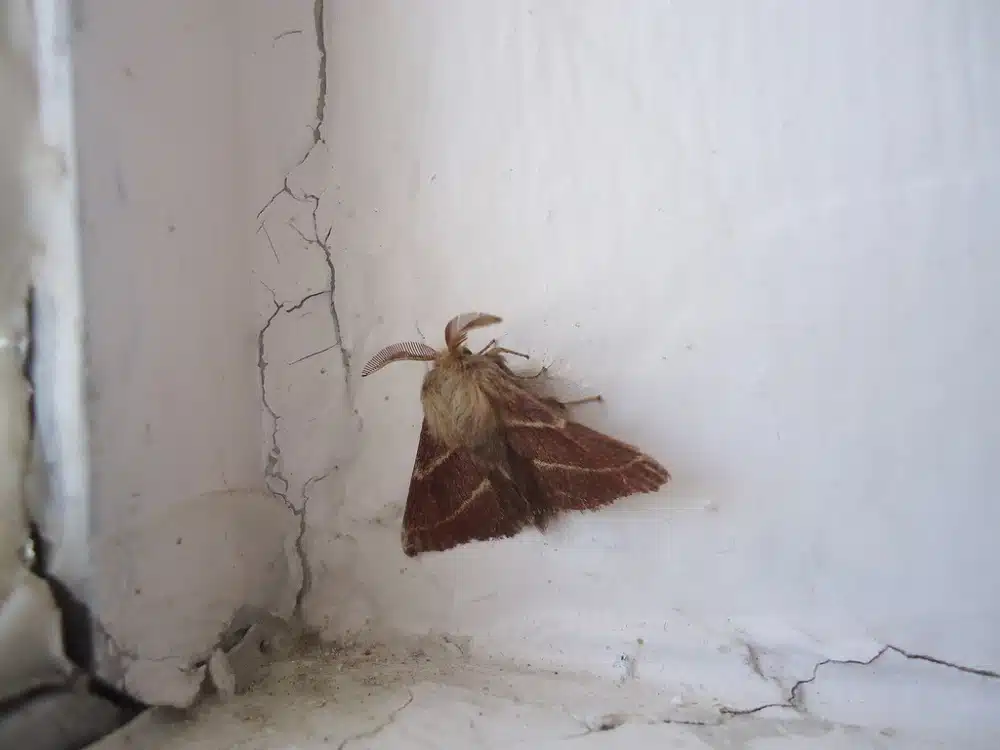
Found in the Western territories in The Central and Southern parts of The Rockies, this furry moth (Malacosoma californica) is attributed to various tree hosts.
Alder and aspen are among its typical hosts. The species also feeds on chokeberry.
Yellow to brown coloring is specific to these moths. The female is always brighter.
Males have a base brown color with dark brown wave-shaped marks and yellow sections across their wings.
Its hair body is mostly brown.
The caterpillars of the species also show scarce long hairs along the sides. These caterpillars build protective tent-like structures.
A blue mid-dorsal color is specific to these types of caterpillars.
Complete tree defoliation has been attributed to these caterpillars, particularly on aspen.
25. Spiny Oak-slug Moth

Dark brown and green colors are specific to the furry-looking Spiny Oak-slug Moth (Euclea delphinii).
This species has dark brown to black hairy wings, legs, and a similar body with long hairs.
Unlike other furry brown moths, it also shows contrasting bright green spots on its wings.
This species of moths are believed to take on this contrasting appearance to confuse predators about its identity.
A potentially toxic profile is also attributed by predators to its spiny caterpillar. The Spiny Oak-slug Moth Caterpillar has large green spines and a green body with warning orange and yellow stripes.
26. Arcigera Flower Moth

A hairy body and fluffy wings are specific to the brown Arcigera Flower Moth (Schinia arcigera).
This is a species with a combination of colors such as dark brown, gray, and tan across its wings and body.
While its ventral wings are also brown, the shades are brighter on its underside.
Part of a wider group of moths in the Northeastern US habitats, the Arcigera Flower Moth is a species that is active until early fall.
It never grows more than 25mm in a wingspan.
27. American Lappet Moth

The leaf-mimicking American Lappet Moth (Phyllodesma americana) is one of the hairy species of the continent.
Different shades of brown are specific to this type of moth. Brown with red undertones as well as various shades of gray are used in its mimicry techniques.
It rests its wings in the form of a tent trying to resemble a dead leaf.
A hairy brown and gray upper body is specific to the species.
Common throughout the summer, the American Lappet Moth is among the species that feed on alders and birch.
28. Eastern Grass Tubeworm Moth

A hairy upper body is also specific to the Eastern Grass Tubeworm Moth (Acrolophus plumifrontella). This month is only furry on the upper side of its body, just around its head.
Dark gray, light gray, and black are the main mottled colors spotted on the species. Its fluffy upper body is mostly brown to black.
Its lower body and its wings are slightly hairy but to a lesser extent.
April marks the early season start for the Eastern Grass Tubeworm Moth.
29. Smaller Parasa Moth

A fuzzy colorful appearance is also characteristic of The Smaller Parasa Moth (Parasa chloris). This is a species with a fuzzy body.
An upper green furry body is specific to the species but the rest of its body and its wings are also fuzzy.
Its legs are covered in long brown hairs while its fuzzy wings are mostly green with brown bordering.
Unlike other species, the Smaller Parasa Moth doesn’t have fuzzy antennae.
30. Echo Moth

Echo Moths (Seirarctia echo) are specific to Southeastern US states such as Florida. This is a species with white and orange color combinations.
Its wings are mostly white with orange stripes. Its legs are orange and black.
A fuzzy body is characteristic of the Echo Moth, particularly on its upper part.
The wings are also slightly fuzzy while its legs are smooth.
Echo Moths are found on various host species such as oak and lupines.
31. Marsh Dagger

Marsh Dagger (Acronicta insularis) is one of the few types of furry moths that may feed in grasses.
While they can also lay eggs on trees so that the caterpillars can feed on the leaves, these types of moths are also spotted on grasses and sedges.
A furry brown and yellow body is specific to the species.
Its caterpillars are mostly black but also grow long and scarce white hairs.
32. Frilly Grass Tubeworm Moth
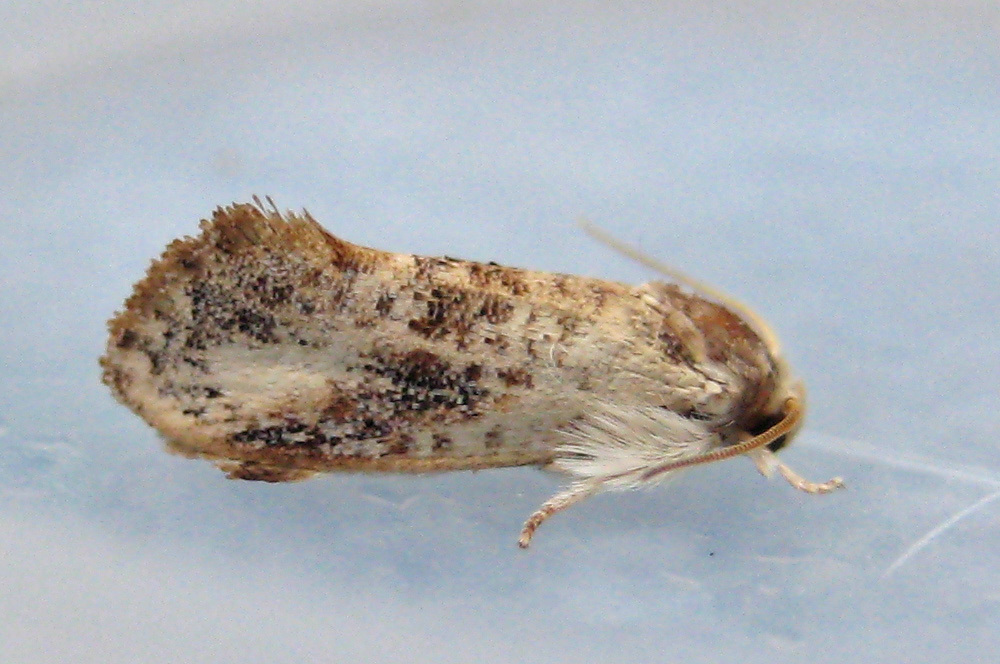
A furry brown and white color is specific to the Frilly Grass Tubeworm Moth (Acrolophus mycetophagus). This is a species that shows multiple brown spots across its wings.
With a wingspan of up to 17mm, the Frilly Grass Tubeworm Moth is one of the smallest types of furry moths.
Moths of this species have furry upper bodies.
This species has a numerous presence in the Southern parts of the United States.
33. Vestal Tiger Moth

One of the moths that are very furry on its upper body is The Vestal Tiger Moth (Spilosoma vestalis).
This white moth has a fuzzy appearance and pure white coloring. Black spots contrast its body and its wings.
This fluffy type of white moth is seen at the beginning of the summer feeding on Red alder and Garry oak.